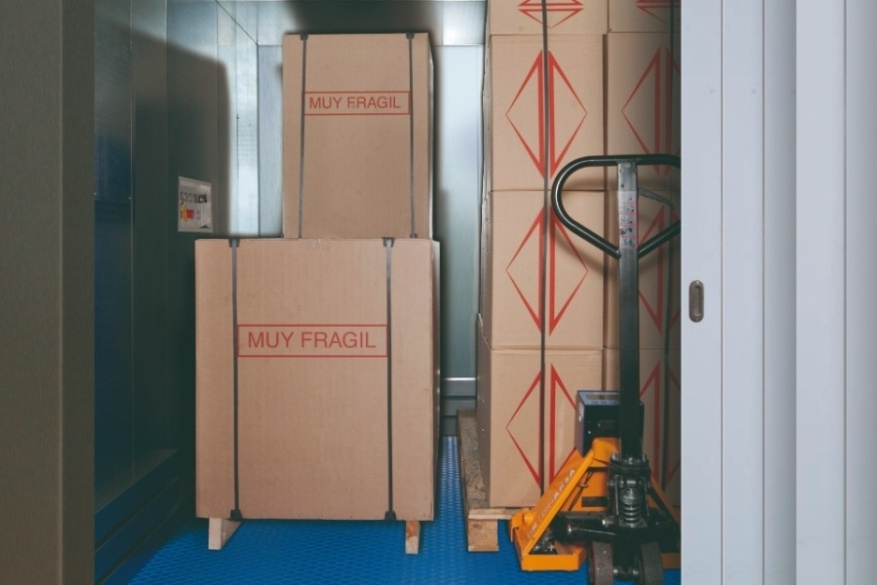- Unternehmen
- Produkte
- Kundenportal
- News
- Kontakt
- Ecommerce
- Marketing & Vertrieb:
+34 954 514 500
sales@hidral.com
This website uses its own and third-party cookies to improve our services and collect information about your browsing. If you click "accept" or continue browsing, we will consider that you accept the use and installation of your device or device. You will find more information in our Cookie Politik.
24/04/24

The handling of heavy loads is a task that involves inherent risks for workers in a variety of industrial and commercial sectors, and to avoid them there are solutions such as goods lifts, which allow the movement of loads in a safe way. Each year, a significant number of workplace injuries and accidents are attributed to manual material handling, underscoring the importance of addressing this concern proactively.
In this context, the prevention of occupational risks becomes a fundamental priority to ensure the safety and well-being of employees in the workplace. This is achieved by providing effective solutions such as goods lifts or other load handling devices.
Manual handling of heavy loads is a physically demanding task that can lead to musculoskeletal injury, fatigue and stress for workers. In addition, lack of proper equipment and improper handling techniques can further increase the risk of occupational accidents. It is crucial to implement effective measures to mitigate these risks and promote health and well-being in the workplace. The installation of goods lifts emerges as one of the most widespread options for the transport of heavy loads.
Goods lifts are specifically designed to transport heavy loads vertically in a safe and efficient manner. Their use not only reduces the exposure of workers to physical risks, but also optimises and speeds up material transport processes compared to other solutions such as cranes or manual trucks.
There are different types of goods lifts adapted to the various needs and operational requirements of each company.
This type of goods lift is designed to transport the load only, without the presence of operators inside. These are very versatile devices, whose load capacity ranges from 100 kg to 20 tons, depending on their use, capacity, location and structure.
These handling solutions do allow operators and workers to travel alongside the load. In this case, the minimum capacity is up to 1000 kg and can reach up to 5000 kg.
Safety devices are essential for the safe transport of goods and personnel in both single-load and accompanied-load models.
The installation of these devices offers a number of significant benefits to companies handling heavy loads. These equipment optimise material movement processes by streamlining the transportation of heavy loads, leading to increased productivity and operational efficiency in the workplace.
Another important benefit is the versatility of goods lifts, which can be adapted to a variety of environments and specific loading needs. Whether in warehouses, factories, distribution centres or construction sites, these devices can offer customised material movement solutions to meet the unique demands of each business.
The installation of goods lifts for the handling of heavy loads is crucial in the prevention of occupational hazards. These devices offer a safe and efficient solution for lifting and transporting heavy materials, significantly reducing the exposure of workers to injuries and fatigue associated with manual handling.
When installing a goods lift, it is essential to consider several aspects to ensure its safe and efficient operation.
To select the right type of foods lift, it will be necessary to take into account the specific needs of the environment and the activity: load capacity, maximum lifting height, surface on which it will operate, etc.
Building infrastructure is also crucial, as floor load requirements and structural strength must be met to support the weight of the lift and transported loads.
The training of operators for the correct handling of goods lifts is key. They must know how the device works together with the rules and regulations on occupational safety.
At Hidral, we understand why providing innovative and reliable solutions for the handling of heavy loads is important. We offer a wide range of lifts designed to meet the unique needs of each client. With our experience and dedication to responsible labour, we strive to be your partner of choice in the quest for a safer and more productive work environment.
In addition to offering superior quality products, we are committed to providing exceptional service and ongoing technical support to ensure the satisfaction and success of our clients. With Hidral, you can rely on durable solutions for your heavy load handling needs.